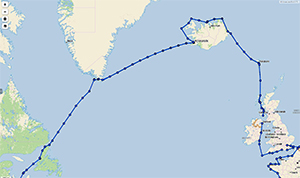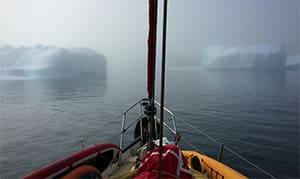Weather routing experts are a fairly exclusive bunch. It’s a profession that requires not only deep meteorological knowledge but also a knack for translating weather data into useable info for vessels at sea. One weather router based in Iceland, Maik Broetzmann, is in an even more exclusive club: He specializes in routing for high-latitude waters, where ordinary weather and waves are joined by ice as a factor in the routing equation. Broetzmann is the founder of HafStrand (www.haf-strand.com), a marine consulting service for yachtsmen seeking adventure beyond their usual comfort zone. As a trained meteorologist and experienced yachtsman, he is passionate about supporting others in achieving their dreams. Broetzmann lives in the Westfjords of Iceland, a day’s sail from the East Greenland coast, his favorite exploration grounds.
Ocean Navigator: For what types of vessels do you commonly perform weather routing services? Both commercial and recreational?
Maik Broetzmann: I specialize in helping private leisure vessels, both motor and sailing yachts, undertake challenging cruises and ocean crossings. My clients are all recreational sailors, but some also have hired crew aboard. My focus is on yachtsmen who are driven to the sea by passion.
ON: Are different clients interested in different types of routing information? What is the range of information you can provide to them?
MB: Absolutely. Some clients are under time pressure and need to get quickly and safely from point A to B, while others are leisurely cruising. Some look for advice on difficult passages, while others want, for example, to transfer a yacht during off-season or in unfamiliar dangerous waters. Some of my clients prefer off-the-beaten-track adventures, which often lead into ice-infested waters in high latitudes.
I conduct feasibility and safety assessments and ensure that my clients experience the most ideal conditions possible. My routing services encompass more than just weather forecasting. Risk assessment and risk mitigation — including of sea state, freak and rogue wave potential, ice conditions, and local and political issues — are just as important. The information I provide is always tailored to my clients’ needs, communication styles and specific preferences. That said, my services comprise much more than tailored routing information. I also offer advanced route planning and optimization, consultancy on vessel design/adaptation and best-practice advice. I also act as a shore communication link; in continuously monitoring my clients’ progress, I automatically provide an extra layer of security in case of emergency.
 |
|
Weather router Maik Broetzmann is also a sailor. |
ON: What is your background in meteorology? Do you use any specialized high-latitude models for forecasting?
MB: My meteorological background is in marine meteorology, satellite meteorology and downscale errors in high-resolution models. Wanting to learn more about the different climates and weather systems of the globe, I worked for governmental weather agencies in Germany, Iceland, Australia, New Zealand and Fiji.
I use an ensemble of different programs. Some are general large-scale models, which work well over open and even surfaces. Others address the specific local environment encountered. While there is an abundance of model output data available, knowing how to interpret and apply the tools correctly is more challenging. I draw not only from my professional background but also from personal experience. Being a meteorologist and a skilled yachtsman gives me a unique advantage in understanding the conditions my clients face, the developments that are likely to occur, and the best courses of action to take.
ON: What are the special challenges of doing high-latitude weather routing? Is ice prediction the biggest challenge?
MB: High latitudes are a place of extremes in many respects; weather is only one of them. Here it develops and moves much more quickly and with more force, effectively limiting the reliability of forecasts. Moreover, there are far fewer land-based observations that feed into and validate forecast models, leaving satellite data to cover remaining data gaps.
High-latitude summers are short and generally known to be blessed with very calm conditions. However, weather conditions can change unpredictably due to local features such as ice, steep mountains or channeling fjords. Yachtsmen are easily seduced by the summer calm and can end up lingering around for too long, suddenly finding themselves amidst the shoulder season, which tends to announce itself with a bang.
 |
|
The northerly trans-Atlantic route taken by one of Broetzmann’s clients, which involved sailing in Greenland and Icelandic waters. |
Now, pair weather variability with ice movement, uncharted waters within fjords, large areas of shallows, tidal currents, risk of ship icing, extreme katabatic winds in vicinity of a glacier, difficult and limited anchor grounds, and a crew that is new to such conditions. It can be hard to predict events, and even harder to govern outcomes, in high-latitude settings.
Foreseeing ice movement is not easy, and definitely one of the biggest challenges. The combination of poor visibility and fog with ice is a major threat. Katabatic winds, which easily reach 40 to 70 knots, pose another challenge as they strongly depend on local boundary conditions that are hard to observe and compute. They most often happen during sunny, high barometric pressure days with very low winds, and thus appear suddenly and unexpectedly.
High latitudes are a great place for adventure as your skills as a sailor will be put to the test. More importantly, the raw, barren landscapes and abundant wildlife leave you with impressions of such magnitude and contrast you will never forget.
ON: Have most vessel captains using your services familiarized themselves with the dangers of dealing with high-latitude ice?
MB: Most people I know who venture into high latitudes have been inspired by at least one of the early polar explorers. In fact, they have an inner longing to feel like explorers themselves, maybe even to follow the path of explorers like Robert Peary, Fridtjof Nansen, Knud Rasmussen, Sir Ernest Shackleton and Robert F. Scott. Many begin planning years in advance, drawing from books, guides, films or blogs. But, without prior experience, there can be gaps in their preparedness.
Few ice navigation guides are available for yachts; most are focused on industrial vessels. That is why I offer routing and ice navigation guidance, adventure support and advice on managing crew expectations, communication and morale. For clients who are trying ice navigation for the first time, I usually recommend a region that allows for careful first exposure before raising the bar so all aboard get a chance to adjust to their new surroundings. After the adventure, it’s wonderful to hear about their accomplishments, impressions and how their skills have grown.
All of my high-latitude clients either return to the icy waters or plan to do so again in the near future. These latitudes clearly have a very special draw to them. I can’t imagine a better job than helping others achieve their dreams.

